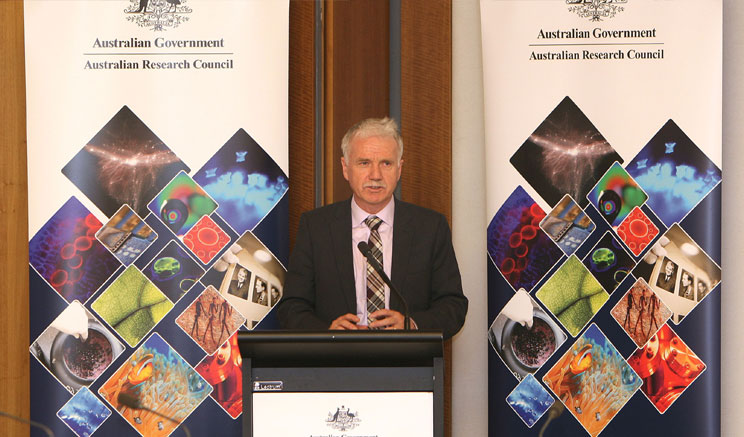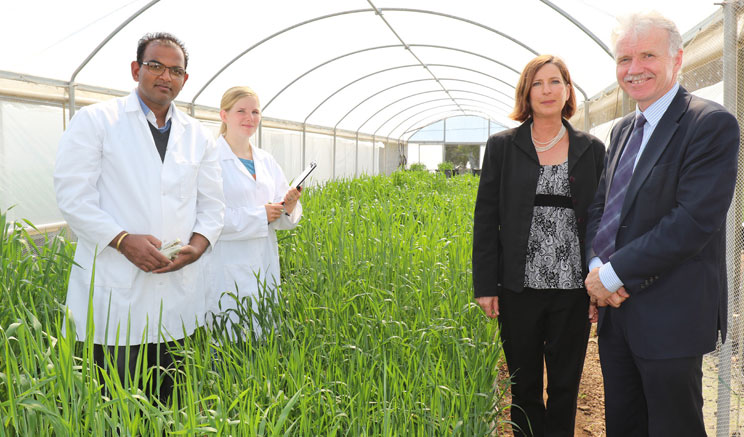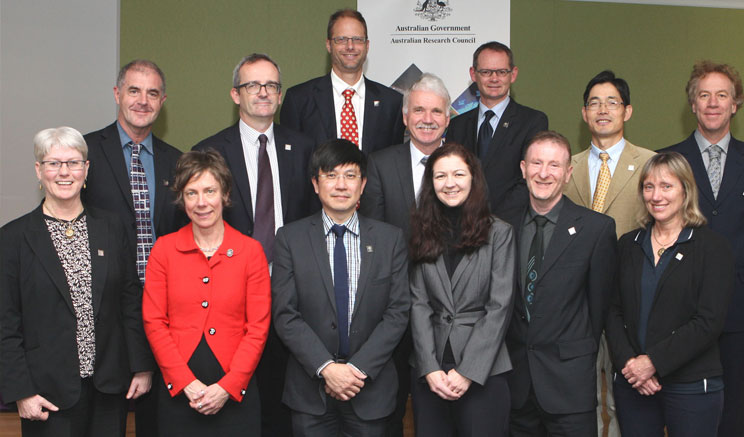The Australian Research Council
Our vision
Research for a creative, innovative and productive Australia
Our mission
To deliver policy and programmes that advance Australian research and innovation globally and benefit the community
Our guiding principles
- Excellence in achieving our mission
- Benefit to the community through economic and social return on investment, engaged and informed decision-making and efficiency of operations
- Engagement with government, universities, research agencies, businesses and the wider community, nationally and internationally
- Accountability through adherence to ethical standards and government policy using transparent, efficient and effective processes
1.1 Review by the Chief Executive Officer

Ms Leanne Harvey Acting Chief Executive Officer
Introduction
I am pleased to present the Australian Research Council (ARC) Annual Report for 2015–16.
As Acting Chief Executive Officer (CEO), I would like to begin by acknowledging the contribution of Professor Aidan Byrne who was the ARC’s CEO until recently. Professor Byrne has now taken up the position of Provost at The University of Queensland. Since joining the ARC in 2012, Professor Bryne has been a tireless advocate, not only for the ARC, but for Australian research and researchers more generally. During his leadership, he was instrumental in the delivery of a range of key priorities within the agency, including refinements to Excellence in Research for Australia (ERA), redevelopment of the grants ICT systems, and increasing accountability and openness with ARC data. More recently Professor Byrne has actively driven work on implementing the new engagement and impact assessment for Australia as well as the continuous application and assessment processes under the Linkage Projects scheme. His presence at the ARC will be missed.
The year in review—significant developments
During 2015–16, a range of research policy activities initiated by the Australian Government were finalised. In December, the Government released the National Innovation and Science Agenda (NISA), announcing $1.1 billion over four years for a range of initiatives to support innovation across the Australian economy. The development of NISA was informed by a range of supporting activities including the Review of Research Policy and Funding Arrangements (the Watt review) and the Boosting the Commercial Returns from Research strategy. As part of NISA, the ARC was assigned responsibility for developing and implementing two new initiatives—an engagement and impact assessment and a continuous application and assessment process for the Linkage Projects scheme.
Importantly, passage of the Higher Education Legislation Amendment (Miscellaneous Measures) Bill 2015 meant that funding for the Future Fellowships scheme, which is focused on mid-career researchers, was secured as an ongoing scheme. The commitment to fund 100 four-year fellowships per year from 2016 onwards was welcomed by the sector. The end of the early career and movement into mid-career is recognised as a critical point in the timeline of a researcher’s employment. It is the point at which many researchers make the decision to pursue research as a lifetime career, and continuation of the Future Fellowships scheme reflects the Australian Government’s recognition of that fact.
The year in review—highlights of performance
Research grants awarded
Through the National Competitive Grants Programme (NCGP) the ARC awarded 1227 new research grants with total funding of $563 million commencing in 2015–16 (comprising 265 fellowships and awards, 11 training centres and research hubs and 951 research projects). These are the visible outputs of the ARC’s activities each year, but as indicated by our performance criteria (pages 18–58) they are much more than that. They are the means by which the NCGP is helping to build Australia’s research capacity, supporting the training and career development of the highest-quality researchers, helping them build linkages with researchers and organisations here and overseas and growing Australia’s capability in areas of priority. In the longer term, they are the discoveries and developments that will help build Australia’s knowledge base and maintain our quality of life. All of these elements are described in Section 2.2.
Release of ERA National Report
The Government released the State of Australian University Research 2015–16: Volume 1 ERA National Report in December 2015. The report shows the quality of Australian university research has continued to improve, with the majority of research at Australian higher education institutions rated at world standard or above. There was a general increase in ratings with more universities moving to 3, 4 and 5 ratings compared to 1 and 2. This is great news for Australia and shows how ERA has been an important driver to focus attention on the quality, not just the quantity, of Australian research. I would like to acknowledge the contribution of everyone involved including universities, research evaluation committees and ARC staff.
Policy development
This year the ARC released a statement of support and expectations for gender equality in research as well as an associated action plan. The ARC faces challenges as a research funding body in promoting the equality and status of women—the release of the statement articulates our commitment to take action in this area and to monitor the resulting outcomes of those actions. It is a longer term challenge because while the success rates of male and female applicants are relatively even, improvements are still needed in the participation rate of female researchers. Our release of a consolidated set of gender statistics at the same time as the statement and action plan is helping to highlight the importance of this dimension.
We also continued to work with the National Health and Medical Research Council (NHMRC) and Universities Australia in a review of the Australian Code for the Responsible Conduct of Research (Code). Adhering to the Code, which guides researchers in responsible research practices, is a condition of ARC and NHMRC funding. With the current version of the Code dated 2007, it is being reviewed now to ensure it remains practical and relevant to research practice which is critical to its ongoing acceptance by the research sector.
Stakeholder engagement
In December 2015 the ARC was proud to co-host, with Papua New Guinea, the Asia-Pacific Regional Meeting of the Global Research Council in Canberra. The meeting discussed research policy and compared experiences and lessons learned for issues which cross national boundaries. Particular areas of focus at this meeting were interdisciplinary research and gender equality, with outcomes informing the full meeting of the Global Research Council attended by Professor Byrne in India in May 2016.
New ARC website
In July 2015 we launched a new ARC website which has been well-received by our stakeholders. As part of that process we ensured the website met the Web Content Accessibility Guidelines. We also took the opportunity to develop and release some new functionality for the website with a new ARC Grants Search launched on the same day. The Grants Search makes it easier for our stakeholders to find details of all ARC-funded research projects since 2002, when the NCGP was first established.
Research Management System
A pillar of our engagement with researchers and universities applying for NCGP funding is our Research Management System. During the year, we worked to make it easier for researchers to submit their applications and receive funding announcement material through the system, reducing the time researchers spend applying for ARC grants and reporting on them, allowing them to focus on research. To date this has been met with great enthusiasm and we are planning to make further improvements in post-award functionality, including revisions to the final reporting arrangements for ARC-funded research projects.
Financial management
The ARC’s total appropriated resources for 2015–16 were $846.1 million, comprising $821.1 million for the administered appropriation and $24.6 million for the departmental appropriation. Further information on the financial performance of the agency is provided in Section 2.5.
Outlook for 2016–17
During 2016–17, the measures announced as part of NISA will continue to be a priority for the ARC. The continuous application process for the Linkage Projects scheme was opened 1 July 2016, but we expect that there will be ongoing work to ensure the process is efficient and effective. With the assistance of the sector, we will also continue to develop the engagement and impact assessment. We are working towards pilot assessments in 2017, followed by the first national assessment in 2018 which will run at the same time as the next round of ERA. Both measures will support greater engagement between industry and the research sectors and support innovation in Australia.
With the third round of ERA now complete, making use of the exceptional longitudinal dataset available to us will be a priority over the coming year. We are looking forward to releasing, for the first time, additional ERA volumes that will give further insights into the state of Australian university research.
And we are also looking forward to welcoming a new CEO to the agency.
Key elements of the ARC’s 2015–16 policy environment
The year in photos



